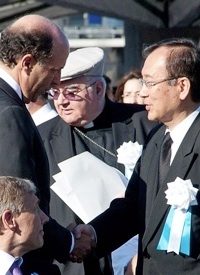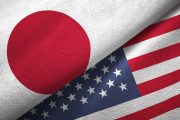
On the 65th anniversary of the first use of nuclear weapons in warfare against a civilian population, a new precedent was set as U.S. Ambassador to Japan John Roos attended the annual Hiroshima Peace Memorial ceremony honoring the victims of the bombing in Hiroshima, Japan — the first time a U.S. official was present at the event.
Speaking at the ceremony, Japanese Prime Minister Naoto Kan invited the other nations of the world to “accept the Japanese people’s hope that nuclear destruction never takes place again."
In a press conference following the ceremony, Kan balanced the pacifist, anti-nuclear position that is prevalent among Japanese today with the reality that Japan relies on the U.S. nuclear arsenal to protect the nation from potential enemies, including North Korea. He noted that while “[the Japanese] share strong hopes for nuclear disarmament,” Japan had to face the “reality that nuclear arms and other weapons of mass destruction are spreading,” and that “nuclear deterrence continues to be a necessity for our country.”
The Christian Science Monitor reported that at the ceremony, the names of an additional 5,501 people recently confirmed to have died from radiation’s aftereffects as a result of the atomic bombings of Hiroshima and Nagasaki were added to the memorial to the dead. The cenotaph now contains almost 100 books containing the names of 269,446 people.
Though the United States did not accede to the Japanese request to apologize for the bombing, Ambassador Roos did use the occasion to promote nuclear disarmament: "For the sake of future generations we must continue to work together to realize a world without nuclear weapons."
There are certain ironies in the Japanese aversion to nuclear weapons while remaining dependent on U.S. nuclear might for its protection. This dependence was actually encouraged by Japan’s postwar constitution, which was was drawn up under the U.S. occupation that followed World War II. The constitution is notable for including a "Peace Clause" (Article 9) that renounced war and banned Japan from maintaining any significant armed forces. However, with time, and with U.S. approval, Japan has increased its conventional armed forces as the United States correctly perceived the communist nations of Asia as being more of a threat to world peace than Japan.
Regarding the continued U.S. refusal to apologize for the mass destruction and killing caused by the atomic bombs of the two cities, many Americans assert that they were necessary acts of war. The official position defending the bombings was that Japan had vowed never to surrender, and that the bombings ended the war sooner, sparing many lives, both U.S. and Japanese.
However, in our article, “U.S. to Send First Delegation to Hiroshima A-Bomb Ceremony,” we presented evidence that Japan actually tried to surrender long before two of its cities and their inhabitants were incinerated by weapons so terrifying that many people wanted to ban them entirely, or else turn their control over to the UN. The following is an except from that article:
Among the best evidence making a case that the United States deliberately delayed Japan’s surrender to allow enough time for Germany to be defeated and for the Soviet Union to shift its attention away from the West and to enter the war against Japan, was presented in the 1956 book, The Enemy at His Back, by journalist Elizabeth Churchill Brown, the wife of noted Washington Star columnist Constantine Brown. Mrs. Brown had access to many of "the men who were no longer ‘under wraps,’" as she noted. She wrote, "With this knowledge at hand, I quickly began to see why the war with Japan was unprecedented in all history. Here was an enemy who had been trying to surrender for almost a year before the conflict ended."
In her book, Brown supplied abundant evidence about the treachery that prevented the Japanese from surrendering until the Soviets were able to enter the war against Japan and U.S. forces had dropped the atomic bombs on two Japanese cities.
A sobering assessment was presented by Admiral William Leahy in his 1950 work I Was There, in which he discussed his reaction to the use of the bomb:
It is my opinion that the use of this barbarous weapon at Hiroshima and Nagasaki was of no material assistance in our war against Japan. The Japanese were already beaten and ready to surrender….
It was my reaction that the scientists and others wanted to make the test because of the vast sums that had been spent on the project…. My own feeling was that in being the first to use it, we had adopted an ethical standard common to the barbarians of the Dark Ages.
More evidence was offered by Admiral Ernest J. King in his 1952 book Fleet Admiral King, wherein he reported President Roosevelt’s 1942 understanding that "by the application of sea power, Japan could be forced to surrender without an invasion of her home islands." However, noted Ling, this position, which was shared by most of our military leaders, was quickly abandoned by Roosevelt.
In his article “Dropping the Bomb,” in the August 21, 1995 issue of The New American magazine, publisher John F. McManus wrote:
The first atomic bomb was exploded over Hiroshima on August 5, 1945; the second was detonated over Nagasaki four days later. On August 8th, the Soviet Union declared war on an already beaten Japan. But other Japanese attempts to surrender had been coming fast and furious prior to these historically important developments.
One of the most compelling was transmitted by General MacArthur to President Roosevelt in January 1945, prior to the Yalta conference. MacArthur’s communiqué stated that the Japanese were willing to surrender under terms which included:
• Full surrender of Japanese forces on sea, in the air, at home, on island possessions, and in occupied countries.
• Surrender of all arms and munitions. Occupation of the Japanese homeland and island possessions by allied troops under American direction.
• Japanese relinquishment of Manchuria, Korea, and Formosa, as well as all territory seized during the war.
• Regulation of Japanese industry to halt present and future production of implements of war.
• Turning over of Japanese which the United States might designate war criminals.
• Release of all prisoners of war and internees in Japan and in areas under Japanese control.
Amazingly, these were identical to the terms that were accepted by our government for the surrender of Japan seven months later. Had they been accepted when first offered, there would have been no heavy loss of life on Iwo Jima (over 26,033 Americans killed or wounded, approximately 21,000 Japanese killed) and Okinawa (over 39,000 U.S. dead and wounded, 109,000 Japanese dead), no fire bombing of Japanese cities by B-29 bombers (it is estimated that the dropping of 1,700 tons of incendiary explosives on Japanese cities during March 9-10 alone killed over 80,000 civilians and destroyed 260,000 buildings), and no use of the atomic bomb.
Countless thousands of Japanese civilians perished as a result of the atomic bombs dropped on Hiroshima and Nagasaki. And the world was suddenly and violently brought into the atomic age.
As to who would benefit from refusing Japan’s earlier attempts to surrender, the delay of the war and the bombing of two cities and the killing of their inhabitants:
- The Soviet Union (and it communist allies in China), which, in return for its very brief (August 8–August 14, 1945) participation in the war against Japan received the disputed Kuril Islands and Manchuria, where they found massive stores of arms kept there by the Japanese, and which they turned over to the communist forces of Mao Tse-tung, enabling him to gain control of all of China.
- The internationalists who had long sought to create a new world body to replace the old League of Nations, this time with U.S. participation. Shocked by the horrors of nuclear war (of which Hiroshima and Nagasaki served as living — and dying — examples) a majority of Americans were softened up for the sales pitch offered by the UN’s proponents that it was mankind’s “last best hope for peace.”
Years later, former President Truman attempted to defend his decision to use the bomb against Japan, stating: "The need for such a fateful decision, of course, would never have arisen had we not been shot in the back by Japan at Pearl Harbor in December 1941."
Harry Elmer Barnes, in an article in National Review for May 10, 1958, quoted the response to Truman’s statement by members of the Hiroshima City Council:
Had your decision been based on the Imperial Navy’s surprise attack on your country’s combatants and military facilities, why could you not choose a military base for the target? You committed the outrage of massacring 200,000 non-combatants as revenge, and you are still trying to justify it.
The recent statements by Japanese officials reveal a strong sense of pacifism and an eagerness for world nuclear disarmament, as if the weapons had transported themselves to Japan and done their damage all on their own. Japanese and Americans alike would do better to recognize that nuclear weapons, like all weapons, can be used either to wage war, or to deter aggressors. It is the policies of those holding the weapons, not the weapons themselves, that determine their use.
Photo: U.S. Ambassador to Japan John Roos, left, greets Hiroshima city’s Mayor Tadatoshi Akiba at the Hiroshima Peace Memorial Park to attend the 65th anniversary of the world’s first atomic bombing, Aug. 6, 2010: AP Images



